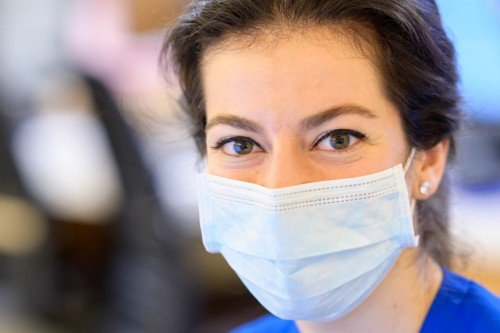Both the Pfizer-BioNTech COVID-19 vaccine (Comirnaty®) and Moderna COVID-19 vaccine (Spikevax™) use messenger ribonucleic acid (mRNA) to stimulate an immune response that can protect against future infection. Memorial Sloan Kettering infectious disease specialist Tobias Hohl discusses the technology of mRNA vaccines.
How do COVID-19 messenger RNA (mRNA) vaccines work?
Traditional vaccines put a weakened or inactivated germ into our bodies. Messenger RNA (mRNA) vaccines, like the Pfizer and Moderna COVID-19 vaccines, teach cells how to make a protein that triggers an immune response if someone gets infected. When the vaccine is injected into the upper arm, the mRNA enters cells near the site of the injection and tells the cells to start making the same protein that is found in the COVID-19 virus. The immune system recognizes this protein and begins producing antibodies that can fight the virus if the vaccinated person is later infected.
None of the vaccines interact with or alter your DNA in any way, and therefore cannot cause cancer. MRNA is not the same as DNA and cannot be combined with DNA to change your genetic code. The mRNA is fragile and it delivers the instructions to your cells to make antibodies against SARS-CoV-2. The mRNA does not enter the nucleus of the cell — the part that contains your DNA. Therefore, there is no truth to the myth that somehow the mRNA vaccine could inactivate the genes that suppress tumors.
The COVID-19 vaccine does not expose you to the virus that causes COVID-19.
Have there been other mRNA vaccines?
These are the first messenger RNA vaccines to be produced and tested in large-scale phase 3 human trials. The advantage of mRNA technology compared with conventional approaches is that it allows for faster development and scale-up of production. Vaccine development has traditionally been measured on the timeframe of a decade. It’s an amazing scientific accomplishment to be where we are right now.
Why do mRNA vaccines need to be stored at such low temperatures?
RNA breaks down easily and quickly unless it is kept at low temperatures. In the body, this isn’t a problem because RNA does not need to exist long in order to carry out its function. But vaccines may need to be kept stable for days or even weeks before they are administered. This has not been nearly as much of a concern with conventional vaccines. Weakened or inactive versions of a virus can remain stable longer without requiring low temperatures.
In the clinical trials, the Pfizer vaccine was kept at minus 70 degrees Celsius (minus 94 degrees Fahrenheit), which requires storage in dry ice. The Moderna vaccine was kept at minus 20 degrees Celsius (minus four degrees Fahrenheit), which is more like a regular freezer. Both vaccines continue to require cold storage — any approval of the vaccines is based on the data generated during the trials, and so the same conditions need to be met.
The idea is that the first shot primes the immune system, helping it recognize the virus, and the second shot strengthens the immune response. Pfizer’s second shot is given three weeks after the first one; Moderna’s is spaced four weeks later. It is very important to have both doses of the same vaccine and follow the same procedures that made the clinical trials so successful.
How can people feel confident that these mRNA vaccines are effective and safe?
We have data from millions of people and we know that they are very effective in preventing severe COVID-19.

Some people have mild to moderate side effects, but they don’t last long — about one to three days. The most common side effects include soreness at the injection site, fatigue (feeling tired), headache, aches, and fever. They are more common after the second dose, and you might need extra rest. Severe side effects are rare and treatable.
It’s very important for people to understand that these data are reviewed by groups independent from the pharmaceutical companies that make the drugs. These are experts who have no stake in the vaccine development or commercialization. I personally had no hesitation in receiving either of these vaccines and I recommended to my family members and colleagues that they take them.
The vaccines are a big part of the solution to this pandemic. But we know that wearing masks and washing hands can even further protect us, especially as new variants emerge.
December 6, 2021
Additional Resources
- Pfizer-BioNTech (Comirnaty®) COVID-19 Vaccine Fact Sheet for people age 6 months through 4 years
- Pfizer-BioNTech (Comirnaty®) COVID-19 Vaccine Fact Sheet for people age 5 through 11 years
- Pfizer-BioNTech (Comirnaty®) COVID-19 Vaccine Fact Sheet for people age 12 years and older
- Moderna (Spikevax™) COVID-19 Vaccine Fact Sheet for people age 12 years and older
- Johnson & Johnson/Janssen COVID-19 Vaccine Fact Sheet for people age 18 years and older
- Novavax COVID-19 Vaccine Fact Sheet for people age 18 years and older

